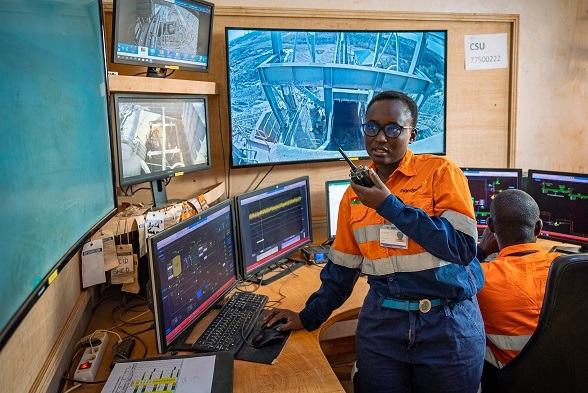Fibre optics are transforming communication in Africa, and this key supplier is helping to upgrade the system in one of the sparsest countries imaginable.
Volker Hesse, managing director of Windhoek Cable Accessories—Namibia’s leading fibre optic supplier—has one irresistible entry on his CV. When you hear that he used to work on installing spy-proof communications systems for Nelson Mandela, you just have to learn more. However, don’t expect to get much information about bugging equipment: even if that aspect of the work ever came under his remit, the Official Secrets Act would make sure his lips are sealed.
He has now settled for a more conventional life, helping to upgrade Namibia’s communications network by installing new fibre optic networks or replacing copper with glass. “Namibia is a vast country,” he says, “with one of the lowest population densities in the world. There are still corners of the country without a reliable telephone service, not to mention the capacity to transmit data. Running copper to the more remote parts of the country would be prohibitively expensive, so fibre is a natural alternative.”
Through his time with the embassies, Hesse learnt which of the many products on the market worked best and then used his contacts to set up a distribution business in Namibia for communication consumables—cable, connectors, accessories and the like. That was in 2005 but it didn’t take long before the business was encouraged to get into installations to provide the proverbial one-stop-shop. In the last two or three years, the emphasis has swung very much towards fibre optics, where Windhoek Cable Accessories (WCA) has quickly established itself as the country’s leading and most reliable supplier.
“Probably the biggest advantage we have over the competition,” says Hesse, “is our expertise in testing cables before and after installations. Our principal customer is the country’s official telecoms provider: Telecom Namibia relies on us to provide them with accurate data on each length of cable in order to calibrate their amplifiers correctly.”
In fact, WCA is the only Namibian company that can ensure that fibre optic cables are carrying the maximum bit rate possible by undertaking testing for optical dispersion, using either polarization mode dispersion or chromatic dispersion techniques.
The longest run of cable which WCA has been involved with measures a staggering 960 kilometres although interestingly, the client in this case was not Telecom Namibia but Nampower, the country’s electricity generator and transmission authority. “Throughout Southern Africa,” says Hesse, “power transmission lines make full use of OPGW [optical ground wire] and we are involved with much of this work on behalf of Nampower.”
It works like this: as well as the power-carrying cables strung between transmission towers, there has to be an earth cable also. OPGW kills two birds with one stone by running as many as 48 fibre optic cables inside a hollow metal earth sheath.
Despite the technology behind fibre optics, the cable runs themselves are often very low-tech. Certainly one of the techniques is to dig trenches and lay the fibre in buried conduit but fibre optic cable is just as likely to be strung between telegraph poles exactly the way phone lines worked a century ago. There is a lot of remoteness in Namibia, providing the perfect cover for weekly attacks by thieves mistaking glass for copper. Once they’ve cut through the line and realised their mistake, the fibre isn’t stolen and simply needs to be reconnected. Hesse is surprisingly philosophical about these acts of vandalism, even though sending out one of his technicians to make repairs must be more of a nuisance than a revenue source. “Namibia is a very poor country,” he says, “with unemployment far too high. Sometimes there is no other option than to steal if you are to feed your family.”
At the head office in Windhoek, WCA practices affirmative action and gives first preference to previously disadvantaged individuals when it comes to appointment of new staff or promotions within the organisation. At the moment, two-thirds of the workforce fall into this PDI category.
Out on site, WCA also tries to create some work for local inhabitants when laying fibre optic cable. “If there are poles to be erected or trenches to be dug,” he says, “we can commission this work locally.”
But the technical work must be done by practiced hands. “Careful attention to detail is essential to make the best connection possible,” he says. “We make sure our technicians are right up to date and fully competent. This can mean refresher courses as frequently as every six months depending on the flow of new connectors or equipment coming onto the market.”
However, Hesse has no plans to make massive increases in size—at least in terms of personnel. The business model he prefers is for WCA to outsource as much of the work as possible. Namibia is such a small market that demand is extremely erratic and fluctuates widely from feast to famine, making it difficult at times to keep a workforce of just 13 fully occupied. The ideal is for WCA to oversee contracted installation, supervising work and running tests to verifying the integrity of connections as they are made.
And there can be a lot of connections. Fibre optic cable comes in runs of four or six kilometres—the selection depending on the weight of that length of cable and whether it is being buried or suspended. Even so, there can be hundreds of joints in the bigger projects—each as critical as the next.
In new buildings it is now common practice to run fibre optic cables instead of copper, not only from a cost point of view but also where there is a risk of data corruption. “Running copper communications alongside electrical supply lines,” says Hesse, “can create magnetic fields which can disrupt data. Hospitals in particular are susceptible. There’s also considerable cost savings to be made considering the long distances found in some of the bigger hospitals which might be spread over large areas and multiple buildings.”
The work for Hesse and his team might not be as glamorous as thwarting political espionage; but it’s every bit as important to the progression and development of the country.
Written by Alan Swaby; research by Stephen Vivian
DOWNLOAD
 Windhoek-EMEA-July12-Bro-s.pdf
Windhoek-EMEA-July12-Bro-s.pdf













